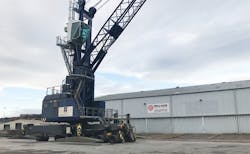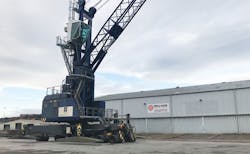Well-Safe launches dedicated well abandonment contracting service
Unique model challenges conventional approach to P&A
Jeremy Beckman
Editor, Europe
Well plug and abandonment (P&A) expenditure across the UK continental shelf last year was forecast to reach around £1 billion ($1.33 billion). Activity will continue to ramp up over the next few years as more UK offshore fields enter the decommissioning phase. Despite the size of the market, however, the industry has lacked a specialist contracting capability able to take on all aspects of North Sea P&A work, from planning through to execution.
Last summer, Aberdeen-based Well-Safe Solutions was formed with an express purpose of filling this void. At the helm are individuals with experience of P&A projects in varying capacities: among them are the company’s founder and executive Director Mark Patterson, formerly of Nautronix; Non-Executive Chairman Alasdair Locke, a previous chairman of oil services specialist Abbot Group; Chief Technical Officer Glenn Wilson, formerly decommissioning manager in the UK North Sea for Repsol Sinopec Resources and Hess; Matt Jenkins, formerly of ConocoPhillips; Paul Warwick, a long-time stalwart of Conoco and ConocoPhillips, and more recently Executive Director at Repsol; and CEO Phil Milton, who brings 26 years of experience in North Sea well services and well abandonment operations on projects for operators including BP, ConocoPhillips and Shell, and latterly with well intervention/production optimization specialist IPM.
Phil Milton. (All images courtesy Well-Safe Solutions)
As Patterson explained during the company’s launch, prior to the oil price slump, North Sea operators had focused more on productivity and had largely deferred decommissioning activity. But with so many mature UK fields approaching life-end, and with an increasing stock of shut-in wells, their priorities have changed.
Well-Safe’s stated aims include providing a differentiated contracting strategy that makes use of economies of scale and challenges conventional approaches to P&A, with a focus on safety and cost reduction. The company, which has attracted funding of £200 million ($267 million), including backing from Scottish Enterprise, offers to manage all aspects of P&A programs for field operators, from planning, engineering and design, logistics through execution, under a single contract and using its own rigs or vessels.
Offshore spoke to Phil Milton about the new company’s goals and how it sees the market developing, both in the UK and elsewhere.
•••
Offshore: How did the management team of Well-Safe Solutions come together, and when did they first discuss the idea of an all-encompassing P&A service?
Milton: Our conversations started around two years ago: Mark, Glenn, Graeme and I all knew each other, both socially and from business discussions. We felt there was a market in the North Sea for a different approach, and we found the response to our ideas and business model quite encouraging.
Offshore: Had the team shared experiences of shortcomings of P&A campaigns they had been involved in, and typically, what were these?
Milton:There had been various issues and concerns, most of which related to the difficulty of getting an offering focused purely on the delivery of P&A projects. Under the existing model, P&A was viewed as the ‘low end’ of the market – drilling contractors would only do it if they didn’t have any other drilling opportunities. We, however, wanted to give the market a service fully focused on P&A, from front-end engineering and design, through detailed design and delivery: a bespoke model, different to anything else on offer.
When we were in our respective companies, we had looked for this type of solution, but couldn’t get it from a single entity. So we discussed what the UK North Sea industry was looking for, and found there were numerous operators in need of P&A for a small number of wells, and therefore anxious to limit their exposure to rig and equipment mob/demob costs. With our model, we can reduce these costs by organizing a schedule for multiple operators based on geographical location, complexity of the wells, and the subsea equipment needed to safely enter these wells.
Offshore: Are cost overruns and schedule delays still common in North Sea well P&A campaigns, and has Well-Safe set targets in terms of improvements?
Milton: They are still happening, because the P&A/decommissioning sector is still in its infancy, although the industry is getting better in terms of delivery and scheduling and we are starting to see reductions to the cost of P&A, but there is a long way to go. One of the benefits of Well-Safe’s P&A Club model is that we retain and pass on the lessons learned from our multi-well, multi-operator campaigns. Traditionally, once these types of projects have been completed, everything is demobilized, the team breaks up, and all learnings are lost. With our model, if we P&A a few wells for an operator and come back to complete the rest later, the operator does not need to keep the original team in place for the second phase: we simply pick up where they left off.
These and other improvements can help the UK North Sea industry achieve the Oil & Gas Authority’s target of a 35% reduction in P&A costs.
Offshore: How did management arrive at the figure of £200 million to cover Well-Safe’s initial needs?
Milton: There were a number of factors. To begin with, we need to attract the best people with the best experience – and they don’t come cheaply – with the right model in place to support them. Our current team is 30-strong, and we expect to have in place 85 onshore personnel by the end of 2018, and eventually around 400 spread between our headquarters in Aberdeen, our Marine Support Base in Dundee, and our offshore P&A assets.
The next priority is assets: we are targeting a semisubmersible rig, a jackup, and a light well intervention vessel to suit all water depths and all types of subsea and surface wells (excluding operations on large platforms with integral drilling packages) throughout the UK North Sea. We have been looking at various different assets, from 3rd generation up to modern or even newbuild rigs, assessing their condition, whether operational, cold or warm stacked, and so on.
The site at Dundee Port.
Initially, we aim to tie up a deal for a semi by 3Q this year at which point we will complete the modification planned to make them bespoke assets for P&A ops. The units we acquire will not return to any form of drilling or well operations in future other than P&A. We are also examining the rigs’ maintenance requirements – certain aspects of these units will be used more heavily for P&A compared with drilling, and vice versa – and their Safety Case/certification needs in order for them to operate in UK waters. At the same time, we have considered the various types of advanced equipment we will need to put on these assets in order to make them bespoke P&A units. For subsea development wells the equipment spread and complexity of the P&A operation will typically be much greater than for a jackup. We have held discussions with specialist equipment suppliers, but will probably hold off cutting first steel until we are further down the road with asset identification.
Offshore: Why has Well-Safe opted to locate its main warehouse in Dundee [south of Aberdeen]?
Milton: Dundee Port Authority has invested £10 million ($13.3 million) in a new quayside that can accommodate heavy-lift vessels, and the deepwater berth means we can also bring our own assets alongside comfortably. In addition, there are many other facilities for decommissioning for services such as decontamination and recycling, while the port’s owner Forth Ports is working with AF Decom to establish a new business focused on topsides decommissioning. We are interested in aligning with environmental services specialists, providing logistical support for P&A, storage of subsea equipment removed from wells, or even recycling of redundant well items – assuming our operator clients are happy to use this site for cleaning and recycling.
Offshore: Is the service limited to the UK sector because of the team’s greater familiarity with the regulatory requirements?
Milton: We are very focused on the UK at the moment: our priorities are to establish our presence and business and to put in place our delivery model. But when we launched, there was also huge interest from Brazil, Mexico and Australia, in fact there is interest in this type of service globally. Over the longer term we are looking to grow our business internationally: it is worth noting that the guidelines on well P&A and suspension that have been developed by Oil & Gas UK are commonly applied elsewhere.
Offshore: Can you explain how Well-Safe’s ‘long-term inflation-linked day rate escalation’ and ‘open book day rate’ models work?
Milton: At the moment, P&A contracts are typically combined with drilling contracts, under which a drilling rig is supplied at an agreed day rate, with options for subcontracting all services required for P&A. However, drilling units are market driven in terms of price, and we expect the market to rebalance over the next few years. A semi today costs $100,000/day, compared to $300-400,000/day for the same unit two to three years ago, and that may return. Well-Safe, however, is looking to offer clients cost certainty for their long-term P&A projects using an inflation-driven rate rather than the market driven rate. By signing up to our P&A Club model, clients can be locked into a multi-year contract under this arrangement, potentially for up to 10 years, if the operator has sufficient numbers of wells facing decommissioning.
In addition, we are offering funding options in certain cases to help clients commit to P&A campaigns. Should operators prefer to allocate their currently available cash for development, we can provide funding solutions for their P&A needs which they can pay back over an agreed period. We are also working with insurance companies looking to offer bespoke insurance policies, including cost overrun insurance, for P&A Club members. This allows them to flatten out their P&A liability costs over the years. Some operators may have 20 wells to P&A, but might only want to do four to five wells at a time. Our model allows them to spread this over several years with the same terms in place.
Offshore:Well-Safe is offering a ‘life-of-well’ P&A service, from the FEED/conceptual phase onwards. From your discussions with various operators, is the industry actually ready for this?
Milton:The feedback we have received has been fantastic; in fact we have been surprised at the positive responses from all areas of the business. Well-Safe’s management team has built up considerable experience working for operators on multi-well P&A campaigns: between us, we have overseen in excess of 150 P&A operations, and that gives confidence to the industry. Ours is a new entity, but we are not new kids on the block.
Offshore: Is the all-encompassing service more relevant to small- to mid-size North Sea operators?
Milton: That is what we had assumed, and that larger IOCs would have focused more on what we can provide during the project execution phase. In fact, we have seen a great deal of interest too from larger companies in our full P&A package and our P&A club has been of great interest to many.
Offshore: Can you provide examples of collaborations between Well-Safe and other UK associations to develop new guidelines and techniques for North Sea P&A?
Milton: We have joined Subsea UK, Decom North Sea, the Oil and Gas Technology Centre [OGTC], and are members of Oil & Gas UK. Matt Jenkins, our Director of Well Abandonment, is the present Chair of the workgroup carrying out the review and re-write of the current well abandonment guidelines: the revised version should be issued early this year. We are also working closely with the Oil & Gas Authority to ensure our service offering is fully aligned with their drivers and to assist with any requests they may have for support.
With the OGTC, we participate in their workshops, evaluating the new technologies in our field that they are supporting, and how to implement them. We see our model as a good way of embedding new technologies, particularly ‘disruptive’ tooling and techniques to drive down the cost of P&A which our commercial model is fully aligned with.


